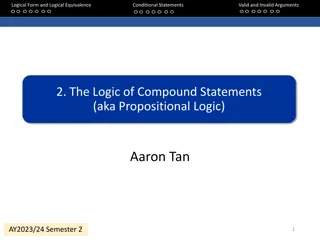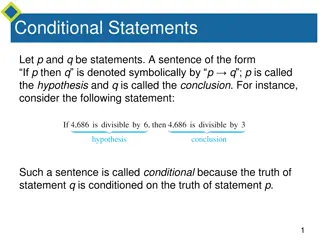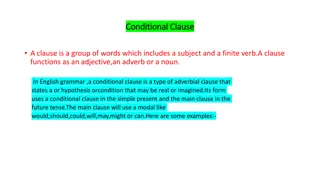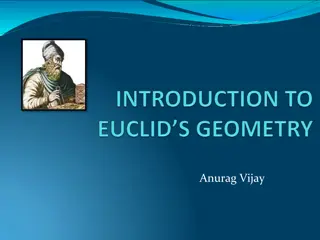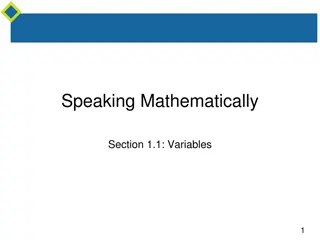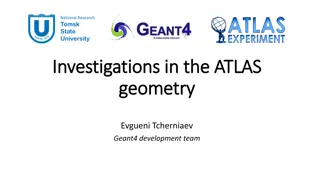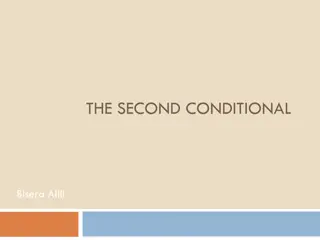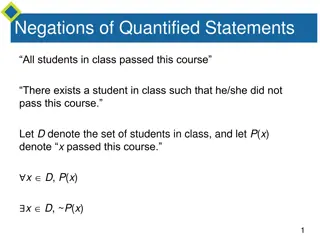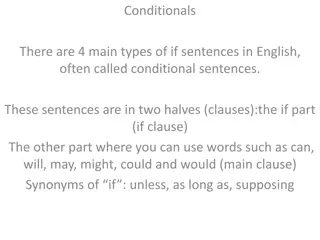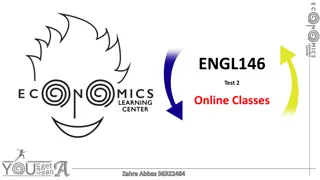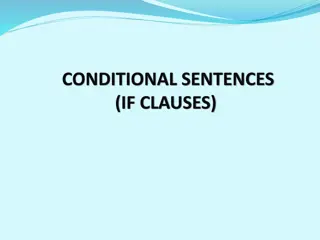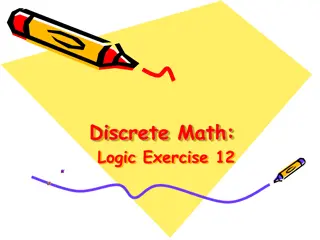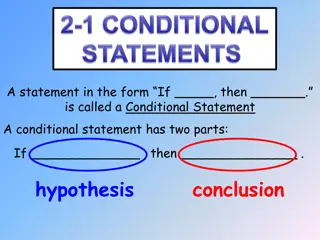Understanding Conditional Statements in Geometry
In this chapter of "Big Ideas Geometry," the focus is on conditional statements in geometry. Learn how to write conditional and biconditional statements, determine if statements are true or false, and explore logical implications such as converse and negation. Through examples and explanations, grasp the foundations of reasoning and proofs essential in geometric arguments and theorems.
Download Presentation

Please find below an Image/Link to download the presentation.
The content on the website is provided AS IS for your information and personal use only. It may not be sold, licensed, or shared on other websites without obtaining consent from the author. Download presentation by click this link. If you encounter any issues during the download, it is possible that the publisher has removed the file from their server.
E N D
Presentation Transcript
REASONING AND PROOFS Geometry Chapter 2
This Slideshow was developed to accompany the textbook Big Ideas Geometry By Larson and Boswell 2022 K12 (National Geographic/Cengage) Some examples and diagrams are taken from the textbook. Slides created by Richard Wright, Andrews Academy rwright@andrews.edu
2.1 CONDITIONAL STATEMENTS Objectives: By the end of the lesson, I can write conditional statements. I can write biconditional statements.
2.1 CONDITIONAL STATEMENTS Determine whether each conditional statement is true or false. Justify your answer. i. If yesterday was Wednesday, then today is Thursday. ii. If an angle is acute, then it has a measure of 30 . iii. If a month has 30 days, then it is June. iv. If ADC is a right triangle, then the Pythagorean Theorem is valid for ADC. v. If a polygon is a quadrilateral, then the sum of its angle measures is 180 . vi. If points A, B, and C are collinear, then they lie on the same line.
2.1 CONDITIONAL STATEMENTS Conditional Statement Logical statement with two parts Hypothesis Conclusion Often written in If-Then form If part contains hypothesis Then part contains conclusion If we confess our sins, then He is faithful and just to forgive us our sins. 1 John 1:9
2.1 CONDITIONAL STATEMENTS p q If-then statements The if part implies that the then part will happen. The then part does NOT imply that the first part happened. If you are hungry, then you should eat. John is hungry, so Megan should eat, so
2.1 CONDITIONAL STATEMENTS ~p Negation Turn it to the opposite. Example: The board is white.
2.1 CONDITIONAL STATEMENTS Converse Switch the hypothesis and conclusion q p Example: If we confess our sins, then he is faithful and just to forgive us our sins. p = we confess our sins q = he is faithful and just to forgive us our sins Converse = If he is faithful and just to forgive us our sins, then we confess our sins. Does not necessarily make a true statement (He may be faithful and just, but many people still don t ask for forgiveness.)
2.1 CONDITIONAL STATEMENTS Inverse Negating both the hypothesis and conclusion ~p ~q Example: If we confess our sins, then he is faithful and just to forgive us our sins. p = we confess our sins q = he is faithful and just to forgive us our sins Inverse = If we don t confess our sins, then he is not faithful and just to forgive us our sins. Not necessarily true (He is still faithful and just even if we do not confess.)
2.1 CONDITIONAL STATEMENTS Contrapositive Take the converse of the inverse ~q ~p Example: If we confess our sins, then he is faithful and just to forgive us our sins. p = we confess our sins q = he is faithful and just to forgive us our sins Contrapositive (inverse of converse) = If he is not faithful and just to forgive us our sins, then we won t confess our sins. Always true.
2.1 CONDITIONAL STATEMENTS Write the following in If-Then form and then write the converse, inverse, and contrapositive All whales are mammals.
2.1 CONDITIONAL STATEMENTS Biconditional Statement Logical statement where the if-then and converse are both true Written with if and only if iff An angle is a right angle if and only if it measure 90 .
2.1 CONDITIONAL STATEMENTS All definitions can be written as if-then and biconditional statements Perpendicular Lines Lines that intersect to form right angles m r m Rewrite the definition as a biconditional. r
2.1 CONDITIONAL STATEMENTS Use the diagram shown. Decide whether each statement is true. Explain your answer using the definitions you have learned. 1. JMF and FMG are supplementary 2. Point M is the midpoint of ?? 3. JMF and HMG are vertical angles. 4. ?? ?? 69 #2, 4, 6, 8, 10, 12, 14, 16, 18, 20, 24, 26, 28, 30, 32, 49, 68, 71, 74, 76
2.2A INDUCTIVE REASONING Objectives: By the end of the lesson, I can use inductive reasoning to make conjectures.
2.2A INDUCTIVE REASONING Geometry, and much of math and science, was developed by people recognizing patterns We are going to use patterns to make predictions this lesson
2.2A INDUCTIVE REASONING Conjecture Unproven statement based on observation Inductive Reasoning First find a pattern in specific cases Second write a conjecture for the general case
2.2A INDUCTIVE REASONING Sketch the fourth figure in the pattern Describe the pattern in the numbers 1000, 500, 250, 125, and write the next three numbers in the pattern
2.2A INDUCTIVE REASONING Given the pattern of triangles below, make a conjecture about the number of segments in a similar diagram with 5 triangles Make and test a conjecture about the product of any two odd numbers
2.2A INDUCTIVE REASONING The only way to show that a conjecture is true is to show all cases To show a conjecture is false is to show one case where it is false This case is called a counterexample
2.2A INDUCTIVE REASONING Find a counterexample to show that the following conjecture is false The value of x2 is always greater than the value of x 78 #1, 2, 4, 6, 7, 8, 10, 12, 13, 14, 36, 43, 45, 46, 49
2.2B DEDUCTIVE REASONING Objectives: By the end of the lesson, I can use deductive reasoning to verify conjectures. I can distinguish between inductive and deductive reasoning.
2.2B DEDUCTIVE REASONING Deductive Reasoning Use facts, definitions, properties, laws of logic to form an argument. Deductive reasoning Always true General specific Inductive reasoning Sometimes true Specific general
2.2B DEDUCTIVE REASONING Law of Detachment If the hypothesis of a true conditional statement is true, then the conclusion is also true. Detach means comes apart, so the 1st statement is taken apart. Example: 1. If we confess our sins, then He is faithful and just to forgive us our sins. 1 John 1:9 Jonny confesses his sins God is faithful and just to forgive Jonny his sins 2. 3.
2.2B DEDUCTIVE REASONING 1. If you love me, keep my commandments. 2. I love God. 3. ____________________________________ 1. If you love me, keep my commandments. 2. I keep all the commandments. 3. ____________________________________
2.2B DEDUCTIVE REASONING Law of Syllogism If these statement are true, then this statement is true If hypothesis p, then conclusion q. If hypothesis q, then conclusion r. If hypothesis p, then conclusion r. 1. 2. If we confess our sins, He is faithful and just to forgive us our sins. If He is faithful and just to forgive us our sins, then we are blameless. If we confess our sins, then we are blameless. 3.
2.2B DEDUCTIVE REASONING If you love me, keep my commandments. If you keep my commandments, you will be happy. ______________________________________ If you love me, keep my commandments. If you love me, then you will pray. ______________________________________ 78 #16, 17, 18, 19, 21, 22, 24, 25, 26, 30, 32, 34, 40, 51, 54
2.3 POSTULATES AND DIAGRAMS Objectives: By the end of the lesson, I can identify postulates represented by diagrams. I can sketch a diagram given a verbal description. I can interpret a diagram.
2.3 POSTULATES AND DIAGRAMS Postulates (axioms) Rules that are accepted without proof (assumed) Theorem Rules that are accepted only with proof
2.3 POSTULATES AND DIAGRAMS Basic Postulates (Memorize for quiz!) Through any two points there exists exactly one line. A line contains at least two points. If two lines intersect, then their intersection is exactly one point. Through any three noncollinear points there exists exactly one plane.
2.3 POSTULATES AND DIAGRAMS Basic Postulates (continued) A plane contains at least three noncollinear points. If two points lie in a plane, then the line containing them lies in the plane. If two planes intersect, then their intersection is a line.
2.3 POSTULATES AND DIAGRAMS Which postulate allows you to say that the intersection of plane P and plane Q is a line? Use the diagram to write examples of the 1st three postulates from this lesson.
P 2.3 POSTULATES AND DIAGRAMS B C Interpreting a Diagram A H J You can Assume D F E G All points shown are coplanar AHB and BHD are a linear pair AHF and BHD are vertical angles A, H, J, and D are collinear You cannot Assume G, F, and E are collinear ?? and ?? intersect ?? and ?? do not intersect BHA CJA ?? and ?? intersect at H ?? ?? m AHB = 90
2.3 POSTULATES AND DIAGRAMS Sketch a diagram showing ?? ?? at its midpoint M.
2.3 POSTULATES AND DIAGRAMS Which of the follow cannot be assumed. ? A, B, and C are collinear E ?? line X C B A ?? plane ? ?? intersects ?? at B F line ?? Points B, C, and X are collinear 85 #2, 4, 6, 8, 10, 12, 14, 16, 18, 20, 21, 22, 23, 25, 26, 31, 32, 36, 38, 39
2.4 ALGEBRAIC REASONING Objectives: By the end of the lesson, I can identify algebraic properties of equality. I can use algebraic properties of equality to solve equations. I can use properties of equality to solve for geometric measures.
2.4 ALGEBRAIC REASONING When you solve an algebra equation, you use properties of algebra to justify each step. Segment length and angle measure are real numbers just like variables, so you can solve equations from geometry using properties from algebra to justify each step.
2.4 ALGEBRAIC REASONING Property of Equality Numbers Reflexive Symmetric a = a a = b, then b = a Transitive Add and Subtract Multiply and divide a = b and b = c, then a = c If a = b, then a + c = b + c If a = b, then a c = b c Substitution If a = b, then a may be replaced by b in any equation or expression a(b + c) = ab + ac Distributive
2.4 ALGEBRAIC REASONING Name the property of equality the statement illustrates. If m 6 = m 7, then m 7 = m 6. If JK = KL and KL = 12, then JK = 12. m W = m W
2.4 ALGEBRAIC REASONING Solve the equation and write a reason for each step 14x + 3(7 x) = -1 Solve A = bh for b.
2.4 ALGEBRAIC REASONING Given: m ABD = m CBE Show that m 1 = m 3 A C 1 2 B 3 D E 92 #2, 4, 6, 8, 10, 16, 20, 22, 24, 28, 30, 32, 34, 36, 38, 53, 54, 60, 61, 63
2.5 PROVING STATEMENTS ABOUT SEGMENTS AND ANGLES Objectives: By the end of the lesson, I can explain the structure of a two-column proof. I can write a two-column proof. I can identify properties of congruence.
2.5 PROVING STATEMENTS ABOUT SEGMENTS AND ANGLES Pay attention today, we are going to talk about how to write proofs. Proofs are like making a peanut butter and jelly sandwich. Given: Loaf of bread, jar of peanut butter, and jelly sitting on counter Prove: Make a peanut butter and jelly sandwich
2.5 PROVING STATEMENTS ABOUT SEGMENTS AND ANGLES Congruence of segments and angles is reflexive, symmetric, and transitive. Writing proofs follow the same step as the sandwich. 1. Write the given and prove written at the top for reference 2. Start with the given as step 1 3. The steps need to be in an logical order 4. You cannot use an object without it being in the problem 5. Remember the hypothesis states the object you are working with, the conclusion states what you are doing with it 6. If you get stuck ask, Okay, now I have _______. What do I know about ______ ? and look at the hypotheses of your theorems, definitions, and properties.
2.5 PROVING STATEMENTS ABOUT SEGMENTS AND ANGLES Complete the proof by justifying each P Q S Given: Points P, Q, and S are collinear Prove: PQ = PS QS Statements Points P, Q, and S are collinear PS = PQ + QS PS QS = PQ PQ = PS QS Reasons Given Segment addition post Subtraction Symmetric
2.5 PROVING STATEMENTS ABOUT SEGMENTS AND ANGLES Write a two column proof A B C D E F Given: ?? ??, ?? ?? Prove: ?? ??
2.5 PROVING STATEMENTS ABOUT SEGMENTS AND ANGLES Prove this property of angle bisectors: If you know ??bisects LMN, prove that two times m LMP is m LMN. Given: ??bisects LMN Prove: 2(m LMP) = m LMN 99 #1, 2, 4, 6, 10, 12, 14, 16, 17, 18, 23, 24, 25, 27, 30
2.6 PROVING GEOMETRIC RELATIONSHIPS Objectives: By the end of the lesson, I can prove geometric relationships by writing fl owchart proofs. I can prove geometric relationships by writing paragraph proofs.
2.6 PROVING GEOMETRIC RELATIONSHIPS All right angles are congruent Congruent Supplements Theorem If two angles are supplementary to the same angle (or to congruent angles), then they are congruent Congruent Complements Theorem If two angles are complementary to the same angle (or to congruent angles), then they are congruent
2.6 PROVING GEOMETRIC RELATIONSHIPS Linear Pair Postulate If two angles form a linear pair, then they are supplementary Vertical Angles Congruence Theorem Vertical angles are congruent


